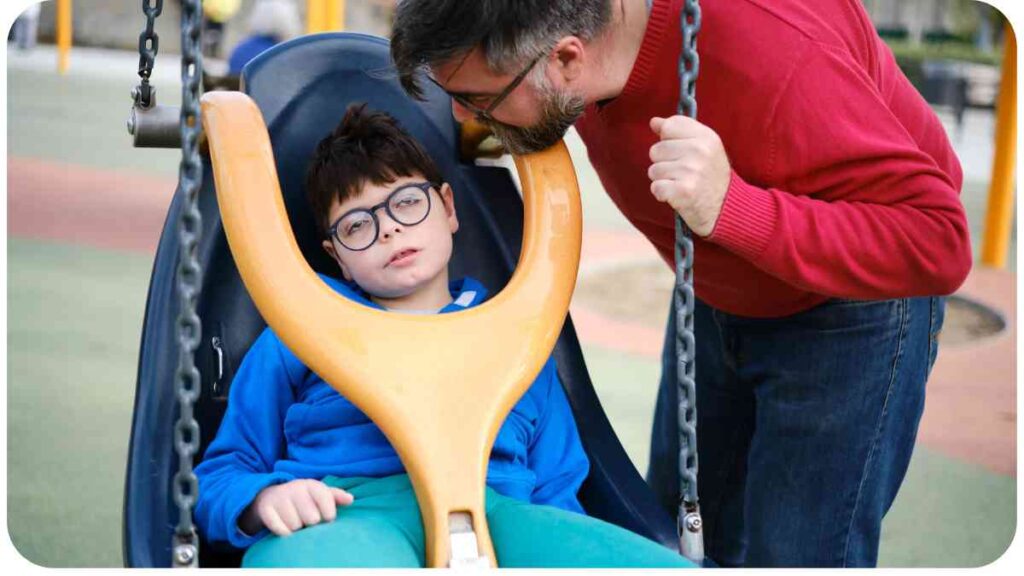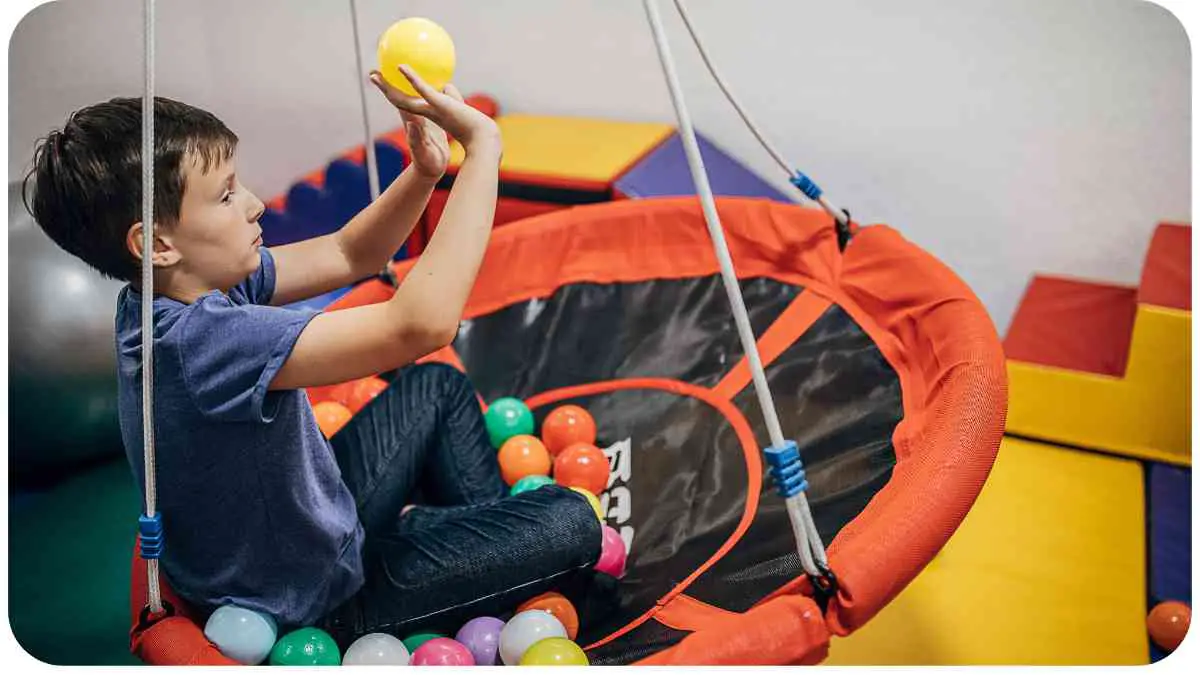Welcome to our comprehensive guide on sensory swings where we will provide you with all the information you need to ensure both safety and enjoyment for your loved ones. Sensory swings are incredible tools that can improve sensory integration, provide therapeutic benefits, and offer a fun and relaxing experience.
In this article, we will explore various aspects of sensory swings, including safety tips, installation guidelines, customization options, and promoting sensory development.
| Takeaways |
|---|
| Sensory swings provide numerous benefits for individuals with sensory processing issues or autism. |
| Proper installation and safety measures are crucial for using sensory swings. |
| Regular maintenance and inspection of the swing ensure safety and longevity. |
| Adjusting the swing to accommodate individual needs, such as height and resistance, enhances the overall experience. |
| Customizing the swing with additional sensory elements can create a more personalized and enjoyable sensory experience. |
| Sensory swings can be used for sensory integration techniques and various sensory activities to promote sensory development and relaxation. |
| Addressing common challenges, such as sensory overload or fear of swinging, requires patience, gradual progression, and a supportive environment. |
| Further reading resources provide in-depth information on sensory swing installation, safety, and tips for maximizing their benefits. |
2. Understanding Sensory Swings
2.1 What Are Sensory Swings?
Sensory swings are specially designed swings that cater to individuals with sensory processing issues, autism, or other sensory-related challenges. These swings provide a cocoon-like environment that promotes a sense of security and relaxation, allowing users to regulate their sensory input effectively.
Sensory play is crucial for toddlers’ development. “Explore our comprehensive guide to choosing the right sensory toys for your little one’s optimal growth and engagement.
2.2 Benefits of Sensory Swings

Sensory swings offer a multitude of benefits. They can help individuals with sensory challenges by promoting relaxation, reducing anxiety, improving focus, and enhancing body awareness. Additionally, these swings can aid in developing coordination, balance, and spatial orientation skills.
2.3 Types of Sensory Swings
There are various types of sensory swings available, each catering to different needs and preferences. Some common types include:
- Hammock-style swings
- Platform swings
- Nest swings
- Bolster swings
2.4 Recommended Age and Weight Limits
It’s important to consider age and weight restrictions when selecting a sensory swing. Always refer to the manufacturer’s guidelines to ensure the swing is suitable for the intended user. This information will help avoid compromising safety and provide the best experience for everyone involved.
Understanding how sensory toys influence speech development is vital. Delve into our analysis to comprehend the profound effects and enhance your child’s language skills.
3. Ensuring Safety
Creating a safe environment for sensory swing usage is paramount. By following these safety guidelines, you can ensure a worry-free experience for both the user and caregiver.
3.1 Choosing a Safe Location
Select a suitable location for your sensory swing. It should have ample space for swinging freely without obstruction. Avoid placing the swing near sharp objects, high traffic areas, or within reach of potential hazards.
3.2 Assembling the Swing Properly
To guarantee the swing’s stability and reliability, carefully follow the assembly instructions provided by the manufacturer. Improper assembly can lead to accidents or injuries.
Discover the transformative power of sensory play for children with special needs. Learn how sensory activities can positively impact development and provide valuable insights for parents and caregivers.
Table – Swing Assembly Instructions:
| Step | Description |
| 1 | Lay out all the swing components and inspect for damage. |
| 2 | Follow the step-by-step instructions provided by the manufacturer to assemble the swing. |
| 3 | Double-check all connections and ensure they are secure. |
| 4 | Test the stability of the swing by gently applying pressure in different directions. |
| 5 | Follow any additional safety precautions mentioned in the manufacturer’s instructions. |
3.3 Securing the Swing
It’s essential to securely attach the sensory swing to a durable and reliable anchor point. Use appropriate hardware and ensure it is properly fastened to provide maximum stability and safety.
3.4 Checking for Stability and Reinforcement
Inspect the swing regularly for stability. Check for any loose connections or signs of wear and tear. Reinforce any weak points or replace any damaged parts immediately. A stable and well-maintained swing is key to safe usage.
3.5 Inspecting for Wear and Tear
Regularly examine the integrity of the swing’s components, including ropes, chains, or seat material. Reinforce any signs of wear, frayed areas, or other indications of potential failure. Replace any worn-out parts promptly to maintain the swing’s safety and longevity.
Empower visually impaired kids with the right sensory toys. Our guide helps you choose toys that engage other senses, fostering an enriching and inclusive play experience.
3.6 Supervising and Setting Boundaries
Supervision is crucial when using sensory swings, especially with children or individuals who may require assistance. Establish clear boundaries, rules, and guidelines to ensure safe and responsible usage. Provide guidance and support as needed, promoting a positive and secure experience.
4. Adjusting the Swing for Individual Needs

Every individual has unique requirements when it comes to sensory swings. Understanding how to adjust the swing based on specific needs is essential to optimize its benefits.
4.1 Adjusting Height and Resistance
Ensure the swing hangs at an appropriate height, allowing for comfortable access and movement. Adjust the swing’s height using adjustable chains or ropes, adapting to different users and their sensory preferences. Experiment with different resistances to find the ideal amount of movement and stimulation.
Transform your home into a haven with our quick guide on creating a sensory space. Explore practical tips and ideas to design a calming environment that supports sensory well-being for all ages.
4.2 Customizing the Swing
Personalization can greatly enhance the sensory swing experience. Consider adding additional sensory elements such as cushions, textured materials, or calming lights, depending on individual preferences and needs. This customization can create a personalized oasis of relaxation and enjoyment.
4.3 Ensuring Proper Body Positioning
Proper body positioning is crucial for comfort and safety. Ensure individuals are positioned correctly in the swing, with their bodies fully supported. Use appropriate safety straps or harnesses to provide stability and maintain the correct posture during swinging motions.
Table – Recommended Adjustments Based on Body Type:
| Body Type | Recommended Adjustments |
| Petite | Use additional cushions for better support. |
| Tall | Adjust the swing’s height to provide ample legroom. |
| Curvy | Opt for swings with wider and more supportive seats. |
| Muscular | Adjust resistance to accommodate strength and movement preferences. |
| Limited Mobility | Consider swings with more extensive support and safety features. |
5. Promoting Sensory Development and Therapy
Sensory swings can be powerful tools for sensory development and therapy. By incorporating various techniques and activities, you can enhance the therapeutic benefits of these swings.
5.1 Sensory Integration Techniques
Sensory integration techniques involve exposing individuals to various stimuli to help their sensory systems process and respond appropriately. Utilize the swinging motion of the sensory swing to provide sensory input while incorporating other sensory elements such as music, scents, or textures.
5.2 Sensory Swing Activities and Exercises
Engaging in specific activities and exercises while using the sensory swing can further enhance sensory development. Here are some examples:
Table – Sensory Activities for Different Ages:
| Age Group | Sensory Activities |
| Toddlers | Gentle swinging with familiar songs or nursery rhymes. |
| Children | Climbing or stretching exercises while swinging. |
| Teens | Incorporating mindfulness or deep breathing techniques during swinging sessions. |
| Adults | Integrating yoga or light stretching routines during swinging for relaxation and flexibility. |
Combining sensory activities and exercises with the unique experience of a sensory swing can create a dynamic and enjoyable therapeutic session.
6. Common Challenges and Troubleshooting
While sensory swings provide countless benefits, users may face challenges or encounters that require troubleshooting. Let’s explore some common issues and how to address them effectively.
6.1 Sensory Overload
Some individuals may experience sensory overload when using a sensory swing. This can manifest as agitation, discomfort, or unease. If this occurs, reduce the swing’s motion or simplify the sensory stimuli to provide a more calming experience.
6.2 Fear of Swinging
Certain individuals might be apprehensive or fearful of swinging motions initially. Start with gentle swinging and gradually increase the intensity as they become more comfortable. Provide reassurance, encouragement, and create a safe and supportive environment to alleviate their fears.
6.3 Swing Maintenance and Cleaning
Regular maintenance and cleaning are essential for the longevity and hygiene of the sensory swing. Refer to the manufacturer’s instructions for specific cleaning guidelines. Inspect the swing periodically for any signs of damage or wear, and address them promptly to maintain a safe and durable swing.
7. Conclusion
Sensory swings are incredible tools for promoting relaxation, sensory development, and therapeutic benefits. By following safety guidelines, customizing the swing to individual needs, and incorporating sensory activities, you can create a safe and enjoyable sensory experience for all.
Remember to regularly inspect and maintain the swing, and address any challenges or concerns that may arise. With sensory swings, you can provide a calming oasis where individuals can discover and regulate their sensory experiences.
Embrace the joy and therapeutic power of sensory swings to enhance well-being and quality of life.
Further Reading
Here are some additional resources to enhance your understanding of sensory swings and their installation:
- The Ultimate Guide to Sensory Swing Installation: Explore this comprehensive guide for step-by-step instructions on installing sensory swings, including valuable tips and insights.
- Sensory Swings: How to Install: This blog post provides a detailed explanation of the installation process for sensory swings, offering practical guidance and expert advice.
- What You Need to Know About Sensory Swings: Discover key information about sensory swings, their benefits, and installation recommendations through this informative article.
FAQs
Here are answers to some frequently asked questions about sensory swings:
Q: Can sensory swings be used by individuals of all ages?
A: Yes, sensory swings can be used by people of various age groups, including toddlers, children, teenagers, and adults. The appropriate swing type and adjustments may vary based on the user’s age and specific needs.
Q: How can I ensure the safety of sensory swing installation?
A: To ensure safety, choose a suitable location, follow proper assembly instructions, secure the swing properly, regularly inspect for wear and tear, and supervise usage. Additionally, refer to industry guidelines and manufacturer recommendations for specific safety measures.
Q: Are sensory swings suitable for individuals with autism?
A: Yes, sensory swings can benefit individuals with autism by providing a calming and regulating sensory experience. The swinging motion and cocoon-like environment can help with sensory integration and promote relaxation.
Q: Can sensory swings be customized for different sensory needs?
A: Absolutely, sensory swings can be customized to accommodate various sensory preferences. Users can adjust the swing’s height, resistance, and incorporate additional sensory elements to create a personalized and therapeutic sensory experience.
Q: What are some common sensory swing activities?
A: Sensory swing activities can include gentle swinging to familiar songs for toddlers, climbing or stretching exercises while swinging for children, and integrating mindfulness or deep breathing techniques during swinging sessions for teens and adults. These activities can promote sensory development, body awareness, and relaxation.

Meet Hellen James, the multi-talented writer and nurturing mother who takes young readers on a thrilling journey through her sensory-infused blog. Drawing inspiration from her own experiences as a parent.

